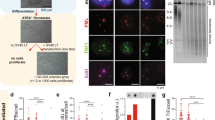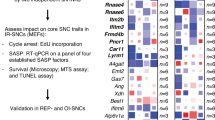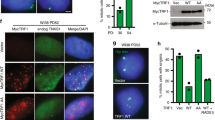Abstract
Ectopic expression of telomerase blocks both telomeric attrition and senescence, suggesting that telomeric attrition is a mitotic counting mechanism that culminates in replicative senescence. By holding human fibroblast cultures confluent for up to 12 weeks at a time, we confirmed previous observations and showed that telomeric attrition requires cell division and also, that senescence occurs at a constant average telomere length, not at a constant time point. However, on resuming cell division, these long-term confluent (LTC) cultures completed 15–25 fewer mean population doublings (MPDs) than the controls prior to senescence. These lost divisions were mainly accounted for by slow cell turnover of the LTC cultures and by permanent cell cycle exit of 94% of the LTC cells, which resulted in many cell divisions being unmeasured by the MPD method. In the LTC cultures, p27KIP1 accumulated and pRb became under-phosphorylated and under-expressed. Also, coincident with permanent cell cycle exit and before 1 MPD was completed, the LTC cultures upregulated the cell cycle inhibitors p21WAF and p16INK4A but not p14ARF and developed other markers of senescence. We then tested the relationship between cell cycle re-entry and the cell cycle-inhibitory proteins following subculture of the LTC cultures. In these cultures, the downregulation of p27KIP1 and the phosphorylation of pRb preceded the complete resumption of normal proliferation rate, which was accompanied by the down-regulation of p16INK4A. Our results show that most normal human fibroblasts can accumulate p16INK4A, p21WAF and p27KIP1 and senesce by cell division-independent mechanism(s). Furthermore, this form of senescence likely requires p16INK4A and perhaps p27KIP1.
This is a preview of subscription content, access via your institution
Access options
Subscribe to this journal
Receive 50 print issues and online access
$259.00 per year
only $5.18 per issue
Buy this article
- Purchase on Springer Link
- Instant access to full article PDF
Prices may be subject to local taxes which are calculated during checkout








Similar content being viewed by others
References
Alcorta DA, Xiong Y, Phelps D, Hannon G, Beach D, Barrett JC . 1996 Proc. Natl. Acad. Sci. USA 93: 13742–13747
Allsopp RC, Vaziri H, Patterson C, Goldstein S, Younglai EV, Futcher AB, Greider CW, Harley CB . 1992 Proc. Natl. Acad. Sci. USA 89: 10114–10118
Allsopp RC, Chang E, Kashefi-Aazam M, Rogaev EI, Piatyszak MA, Shay JW, Harley CB . 1995 Exp. Cell Res. 220: 194–200
Bodnar AG, Ouellette M, Frolkis M, Holt SE, Chiu C-P, Morin GB, Harley CB, Shay JW, Lichsteiner S, Wright WE . 1998 Science 279: 349–352
Burns JE, Baird MC, Clark LJ, Burns P, Edington K, Chapman C, Mitchell R, Robertson G, Soutar D, Parkinson EK . 1993 Br. J. Cancer 67: 1274–1284
Collardo M, Medema RH, Garcia-Cao I, Dubuisson MLN, Barradas M, Glassford J, Rivas C, Burgering BMT, Serrano M, Lam EW-F . 2000 J. Biol. Chem. 275: 21960–21968
Cristofolo VJ, Pignolo RJ . 1993 Physiol. Rev. 73: 617–638
Dietrich C, Wallenfang K, Oesch F, Wieser R . 1997 Exp. Cell Res. 232: 72–78
Dimri GP, Lee X, Basile G, Acosta M, Scott G, Roskelley C, Medrano EE, Linskens M, Rubelj I, Pereira-Smith O, Peacocke M, Campisi J . 1995 Proc. Natl. Acad. Sci. USA 92: 9363–9367
Durand B, Gao F-B, Raff M . 1997 EMBO J. 16: 306–317
Durand B, Fero ML, Roberts JM, Raff MC . 1998 Curr. Biol. 8: 431–440
Goldstein S, Singal GP . 1974 Exp. Cell Res. 88: 359–364
Hara E, Smith R, Parry D, Tahara H, Stone S, Peters G . 1996 Mol. Cell Biol. 16: 859–867
Harley CB . 1991 Mutat. Res. 256: 271–282
Hayflick L . 1965 Exp. Cell Res. 37: 614–636
Holliday R . 1996 BioEssays 18: 3–5
Jiang X-R, Jimenez G, Chang E, Frolkis M, Kusler B, Sage M, Beeche M, Bodnar AG, Wahl GM, Tlsty TD, Chiu C-P . 1999 Nature Genet. 21: 111–114
Jones CJ, Kipling D, Morris M, Hepburn P, Skinner J, Bounacer A, Wyllie FS, Ivan M, Bartek J, Wynford-Thomas, Bond JA . 2000 Mol. Cell Biol. 20: 5690–5699
Kamijo T, van de Kamp E, Chong MJ, Zindy F, Diehl JA, Sherr CJ, McKinnon PJ . 1999 Cancer Res. 59: 2464–2469
Karlseder J, Broccoli D, Dal Y, Hardy S, de Lange T . 1999 Science 283: 1321–1324
Kipling D, Cooke HJ . 1990 Nature 347: 400–402
Kiyono T, Foster SA, Koop JI, McDougal JK, Galloway DA, Klingelhutz AJ . 1998 Nature 396: 84–88
Lee HW, Blasco MA, Gottlieb GJ, Horner II JW, Greider CW, DePinho RA . 1998 Nature 392: 569–574
Makarov VL, Hirose Y, Langmore JP . 1997 Cell 88: 657–666
Mazars GR, Jat PS . 1997 Proc. Natl. Acad. Sci. USA 94: 151–156
McConnell BB, Starborg M, Brookes S, Peters G . 1998 Curr. Biol. 8: 351–354
Morales CP, Holt SE, Ouellette M, Kaur KJ, Yan Y, Wilson KS, White MA, Wright WE, Shay JW . 1999 Nature Genet. 21: 115–118
Olovnikov AM . 1973 J. Theor. Biol. 41: 181–190
Palmero I, Pantoja C, Serrano M . 1998 Nature 395: 125–126
Polyak K, Kato J-Y, Solomon MJ, Sherr CJ, Massague J, Roberts JM, Koff A . 1994 Genes Dev. 8: 9–22
Robles SJ, Adami GR . 1998 Oncogene 16: 1113–1123
Rubelj I, Vondracek Z . 1999 J. Theor. Biol. 197: 425–438
Serrano M, Lee HW, Chin L, Cordon-Cardo C, Beach D, DePinho RA . 1996 Cell 85: 27–37
Serrano M, Lin AW, McCurrach ME, Beach D, Lowe SW . 1997 Cell 88: 593–602
Schor SL, Schor AM . 1987 BioEssays 7: 200–204
Shelton D, Chang E, Whittier PS, Choi D, Funk WD . 1999 Curr. Biol. 9: 939–945
Sitte N, Saretzki G, von Zglinicki T . 1998 Free Rad. Biol. Med. 24: 885–893
Smith JR, Whitney RG . 1980 Science 207: 82–84
van Steensel B, Smogorzewska A, de Lange T . 1998 Cell 92: 401–413
Stein GH, Dulic V . 1995 BioEssays 17: 537–543
Stott FJ, Bates S, James MJ, McConnell BB, Starborg M, Brookes S, Palmero I, Ryan K, Hara E, Vousden K, Peters G . 1998 EMBO J. 17: 5001–5014
Takuwa N, Takuwa Y . 1997 Mol. Cell Biol. 17: 5348–5358
Tresini M, Mawal-Dewan M, Cristofolo VJ, Sell C . 1998 Cancer Res. 58: 1–4
Vaziri H, Benchimol S . 1998 Curr. Biol. 8: 279–282
Vaziri H, West MD, Allsopp RC, Davison TS, Wu Y-S, Arrowsmith CH, Poirier GG, Benchimol S . 1997 EMBO J. 16: 6018–6033
Wong H, Riabowol K . 1996 Exp. Geront. 31: 311–325
Wright WE, Brasiskyte D, Piatyszek MA, Shay JW . 1996 EMBO J. 15: 1734–1741
von Zglinicki T, Saretzki G, Docke W, Lotze C . 1995 Exp. Cell Res. 220: 186–193
Zindy F, Quelle DE, Roussel MF, Sherr CJ . 1997 Oncogene 15: 203–211
Acknowledgements
The authors are very grateful to H Vaziri for the generous gift of the pBabest2 retroviral construct, to Karen Vousden and Gordon Peters for gifts of p14ARF antibodies, to the Cancer Research Campaign and the European Molecular Biology Organisation for financial support (K Steeghs), to Keith Vass for help with statistical analysis and to John Wyke for critical reading of the manuscript.
Author information
Authors and Affiliations
Rights and permissions
About this article
Cite this article
Munro, J., Steeghs, K., Morrison, V. et al. Human fibroblast replicative senescence can occur in the absence of extensive cell division and short telomeres. Oncogene 20, 3541–3552 (2001). https://doi.org/10.1038/sj.onc.1204460
Received:
Revised:
Accepted:
Published:
Issue Date:
DOI: https://doi.org/10.1038/sj.onc.1204460
Keywords
This article is cited by
-
SIRT6-PAI-1 axis is a promising therapeutic target in aging-related bone metabolic disruption
Scientific Reports (2023)
-
Autophagy is deregulated in cancer-associated fibroblasts from oral cancer and is stimulated during the induction of fibroblast senescence by TGF-β1
Scientific Reports (2021)
-
A new isolation and culture method for granulosa cells
Cell and Tissue Banking (2021)
-
The induction of the fibroblast extracellular senescence metabolome is a dynamic process
Scientific Reports (2018)
-
∆133p53 isoform promotes tumour invasion and metastasis via interleukin-6 activation of JAK-STAT and RhoA-ROCK signalling
Nature Communications (2018)



